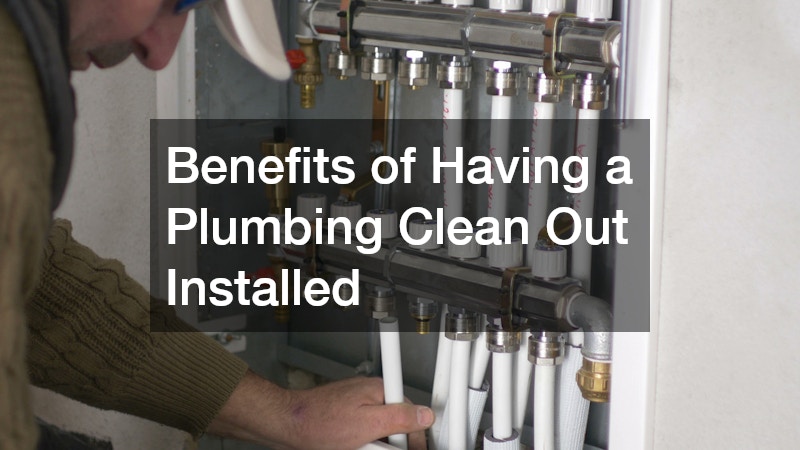

Plumbing is one of those household systems we tend to ignore—until a problem arises. Blocked drains, slow water flow, and unpleasant odours can all cause frustration and inconvenience. That’s where a plumbing clean out comes in. This often-overlooked feature plays a crucial role in maintaining your home’s plumbing health and preventing costly repairs.
In this comprehensive guide, we’ll break down what a plumbing clean out is, why it matters, how to locate it, and what homeowners can do to keep it in top shape. Whether you’re a new homeowner or simply looking to understand your home’s plumbing better, this article will give you all the information you need to stay ahead of potential problems.
Understanding the Basics: What Is a Plumbing Clean Out?
Before you can appreciate its importance, you need to know exactly what a plumbing clean out is. Simply put, a plumbing clean out is an access point installed in your home’s drainage system that allows plumbers to reach the pipes directly. It’s usually a capped pipe protruding slightly from the ground, floor, or wall, and it serves as an entryway for removing blockages, inspecting the sewer line, or performing routine maintenance.
The clean out is typically connected to the main sewer line or significant branch lines. By having this dedicated access point, plumbers can use specialised tools—such as drain augers or hydro jetting equipment—to clear clogs more effectively than if they had to work through sinks, toilets, or showers.
In most residential setups, you’ll find one or more clean outs located:
- Outside the home, near the foundation
- Inside a utility or basement area
- At the property’s edge near the street connection to municipal sewers
A plumbing clean out may not look impressive, but it’s an essential safeguard against plumbing disasters.
Why Is a Plumbing Clean Out Important?
Your plumbing system is a hidden network of pipes carrying waste and water away from your home. Over time, debris like grease, soap residue, food particles, and even tree roots can cause blockages. Without a quick way to access your pipes, clearing these blockages becomes a major challenge—one that could involve tearing up floors or walls.
Here’s why having a plumbing clean out is so important:
- Faster Problem Resolution: Plumbers can get straight to the source of a clog without dismantling fixtures.
- Cost Savings: Avoids unnecessary damage to walls, floors, and landscaping during repairs.
- Effective Maintenance: Makes regular inspections and cleanings easier to perform.
- Prevents Emergencies: Quick access means issues can be addressed before they escalate into backups or floods.
In short, a clean out is like a front door to your plumbing system—it’s the easiest way to get in when trouble arises.
The Function of a Plumbing Clean Out in Your Home

The clean out acts as a service point for your plumbing system, but its role goes beyond just clearing blockages. Let’s look at its main functions:
- Blockage Removal – Clogs in your main sewer line can lead to water backing up into your sinks, tubs, or toilets. The clean out gives plumbers a direct path to remove debris without disturbing your home’s fixtures.
- Inspection Access – Modern plumbing services often use cameras to inspect the condition of pipes. Clean outs allow technicians to insert inspection equipment to locate cracks, leaks, or intrusions like tree roots.
- Maintenance Access – Regular pipe flushing with high-pressure water can prevent build-up. A clean out ensures this process can be done efficiently.
- Pressure Release – In cases of severe blockage, clean outs can be opened to relieve pressure in the system, preventing potential pipe damage.
Without a functioning clean out, you’d be facing a much more invasive and expensive repair process.
Where Is the Plumbing Clean Out Located?
Knowing where your plumbing clean out is located can save you time, stress, and potentially thousands of dollars in repairs. While every home’s layout is different, most clean outs are installed in predictable locations.
Common places to check include:
- Outdoor Clean Outs: Found near the foundation, often with a screw cap sticking up a few inches above the soil or hidden under a protective cover.
- Indoor Clean Outs: In basements, garages, or utility rooms, typically near the point where the sewer line leaves the building.
- Property Edge Clean Outs: At the junction where your home’s line meets the municipal sewer, often near the sidewalk or street.
If you can’t locate your clean out, a plumber can use diagrams or camera inspection tools to find it. In older homes, clean outs may be buried or missing entirely, in which case installation is strongly recommended.
What Is a Clean Out in Plumbing? The Technical Details
For homeowners who want to understand the nuts and bolts, a plumbing clean out is essentially a fitting—often made of PVC, cast iron, or ABS plastic—that connects to the main drain line. It’s capped with a threaded plug or removable cover, which seals the pipe and prevents sewer gases from escaping.
Clean outs are typically installed:
- At the base of vertical waste stacks
- At junction points where two or more lines meet
- At set intervals along long horizontal runs (as required by plumbing codes)
Building codes in most regions dictate where clean outs must be placed and how many a system needs, based on pipe length and layout. The goal is to ensure no section of the drain is too far from an access point for cleaning tools to reach.
Common Issues Without a Plumbing Clean Out
If your home lacks a plumbing clean out, you might face a range of frustrating problems, including:
- Difficult Clog Removal: Without direct access, plumbers may need to remove toilets or cut into pipes.
- Higher Repair Costs: More labour and potential damage to your property increase expenses.
- Increased Risk of Damage: Severe clogs can cause backups that damage floors, walls, and personal property.
- Longer Downtime: Resolving blockages without a clean out can take significantly longer, leaving you without functioning plumbing.
Many older homes were built before modern plumbing codes required clean outs. If this is the case for you, adding one is a worthwhile investment.
How to Maintain a Plumbing Clean Out
While clean outs are designed to be durable, they do require basic upkeep to stay effective. Here are some maintenance tips for homeowners:
- Keep the Area Clear: Avoid covering outdoor clean outs with soil, plants, or decorations.
- Inspect Annually: Check for cracks, loose caps, or signs of corrosion.
- Tighten the Cap: Ensure it’s sealed properly to prevent leaks or odours.
- Call for Professional Cleaning: Even if there are no issues, having your lines cleaned every couple of years helps prevent build-up.
A small amount of preventive care can keep your clean out functional for decades.
DIY vs. Professional Plumbing Clean Out Maintenance
Some homeowners may be tempted to open the clean out and deal with minor clogs themselves. While it’s possible to clear small obstructions using a manual drain snake, there are risks.
- Pros of DIY: Saves money, good for very minor blockages.
- Cons of DIY: Risk of damaging pipes, exposure to hazardous waste, inability to handle deep or stubborn clogs.
Professional plumbers have the tools, training, and safety equipment to address clogs effectively. For anything beyond a superficial blockage, calling in an expert is the safer choice.
How Much Does It Cost to Install or Repair a Plumbing Clean Out?
Costs can vary widely depending on location, accessibility, and your home’s existing plumbing layout. On average:
- Installation: $300 to $1,000 (more if excavation is required)
- Cap Replacement: $20 to $60 for parts, plus labour if needed
- Repairs: $100 to $500, depending on the issue
While these costs may seem high, they are minimal compared to the price of repairing water damage from a major sewer backup.
Signs You May Need to Use Your Plumbing Clean Out
If you notice any of the following signs, it might be time to access your clean out or call a plumber:
- Multiple drains in your home are slow or backed up.
- You smell foul odours coming from drains.
- Gurgling sounds occur when using water in sinks or tubs.
- Wastewater backs up into showers, tubs, or floor drains.
These are often signs of a blockage in the main sewer line, which can be quickly diagnosed and fixed via the clean out.
Benefits of Having a Plumbing Clean Out Installed

Having a plumbing clean out installed (or ensuring your existing one is in good condition) offers several practical advantages for homeowners. Beyond just resolving clogs faster, it contributes to long-term plumbing health and overall home safety. Here are the top benefits:
- Quick Access for Repairs: Technicians can reach the problem area without dismantling toilets, sinks, or walls.
- Lower Repair Costs: Reduces the need for invasive procedures, keeping labour and material costs down.
- Faster Clog Removal: Direct entry into the sewer line means quicker blockage removal.
- Regular Maintenance Access: Makes routine cleaning and inspections simple and cost-effective.
- Prevents Property Damage: Minimises the risk of wastewater backups that can damage floors, furniture, and walls.
- Compliance with Codes: Many areas require clean outs to meet local plumbing regulations.
By investing in or maintaining a plumbing clean out, you’re not only protecting your plumbing system but also safeguarding your property from costly emergencies.
Final Thoughts: Protecting Your Home with a Plumbing Clean Out
A plumbing clean out is a small feature with a big impact. By providing easy access to your home’s drainage system, it allows for faster repairs, better maintenance, and significant cost savings in the long run. For homeowners, understanding its purpose and location is an important part of responsible homeownership.
If your home doesn’t have a clean out, or if you’re unsure of its location or condition, it’s worth consulting a licensed plumber. Investing in proper plumbing access today can save you from major headaches—and expenses—tomorrow.
